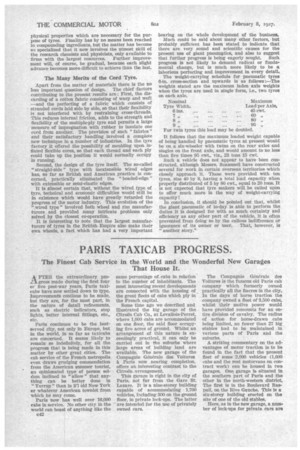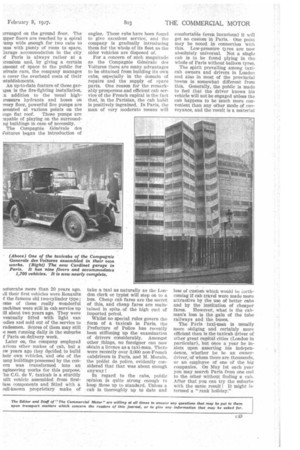PARIS TAXICAB PROGRESS.
Page 108

Page 109

If you've noticed an error in this article please click here to report it so we can fix it.
The Finest Cab Service in the World and the Wonderful New Garages That House It.
A FTER the extraordinary, pro-tigress made during the first four or five post-war years, Paris taxicabs have now settled down to type. Improvements continue to be made, but they are, for the most part, in the nature of detail refinements, such as electric indicators, step lights, better internal fittings, etc., etc.
Paris continues to be the bestserved city, not only in Europe, but In the world, in so far as taxicabs are concerned. It seems likely to remain so indefinitely, for all the progress that is being made in this matter by other great cities. The cab service of the French metropolis even draws grudging commendation from the American summer tourist, an opinionated type of person seldom inclined to " allow " that anything can be better done in " Yurrup " than in li'l old New York or whatever American townlet from
which he may come. • Paris now has well over 16,000 cabs in service. No other city in the world can boast of anything like the c42 same percentage of cabs in relation to the number of inhabitants. The most interesting recent developments are connected with the housing of the great fleets of cabs which ply in the French capital.
Some time ago we described and illustrated the big garage of the Citroen Cab Co., at Levallois-Perret, where 1,000 cabs are accommodated on one door, the said floor occupying Ave acres of ground. Whilst an arrangement of this nature is exceedingly practical, it can only be carried out in the suburbs where large areas of building land are available. The new garage of the Compagnie GO.nerale des Voitures Paris now nearing completion, offers an interesting contrast to the Citroen arrangement.
This garage is right in the city of Paris, not far from the Gare St. Lazare. It is a nine-storey building capable of accommodating 1,700 vehicles, including 300 on the ground floor, in private lock-ups. The latter are intended for the use of privately owned cars. The Compagnie Ge'ne'rale deS Voitures is the famous old Paris cab company which formerly owned practically all the fiacres in the city. In the days of horse traction the company owned a fleet of 3,500 cabs, whilst their motive power would have provided remounts for an entire division of cavalry. The radius of action for horse-drawn cabs being limited, no fewer than 27 big stables had to be maintained in various parts of Paris and the suburbs. .
A striking commentary on the advantages of motor traction is to be found in the fact that the present fleet of some 2,000 vehicles (1,600 cabs and the rest motorvans on contract work) can be housed in two garages. One garage is situated in the southern part of Paris and the other in the north-western district The first is in the Boulevard Respell, on the Rive Gauche. This is a six-storey building erected on the site of one of the old stables.
Here, as In the new garage, a number of lock-ups for private cars are trranged on the ground floor. The mper floors are reached by a spiral -amp wide enough for two cabs to miss with plenty of room to spare. 3arage accommodation in the city A Paris is always rather at a remium and, by giving a certain mount of space to the public for rivate cars, the company manages o cover the overhead costs of their !stablishments.
An up-to-date feature of these gartges is the fire-fighting installation. .n addition to the usual highressure hydrants and hoses on ;very floor, powerful fire pumps are nounted at various points on the mge flat roof. These pumps are mpable of playing on the surroundng buildings in case oe necessity.
The Compagnie Gent',rale des Voitures began the introduction of
notorcabs more than 20 years ago. L.11 their first vehicles were Renaults f the famous old two-cylinder type; ome of these really wonderful nachines were still in cab service up ill about two years ago. They were ventually fitted with light van odies and sold our of the service to radesmen. Scores of them may still e seen running daily in the suburbs f Paris on delivery work.
Later on, the company employed arious other makes of cab, but a aw years ago they decided to build heir own vehicles, and one of the nany buildings possessed by the conern was transformed into an ngineering works for this purpose. 7he C.O. de V. taxicab is a sturdily uilt vehicle assembled from firstlass components and fitted with a veil-known proprietary make of engine. These cabs have been found to give excellent service, and the company is gradually introducing them for the whole of its fleet as the older vehicles are disposed of.
For a concern of such magnitude as the Compagnie Gendrale des Voitures there are many advantages to be obtained from building its own cabs, especially in the domain of repairs and the supply of :Tare parts. One reason for the remarkably prosperous and efficient cab service of the French capital is the fact that, in the Parisian, the cab habit is positively ingrained. In Paris, the man of very moderate means will take a taxi as naturally as the London clerk or typist will step on to a bus. Cheap cab fares are the secret of this, and cheap fares are maintained in spite_ of the high coat of imported petrol.
Whilst no special rules govern the form of a taxicab in Paris, the Prefecture of Police has recenlly been stiffening up the examination of drivers considerably. Amongst other things, no foreigner can now obtain a licence as a taxi-nnan. There were recently over 3,000 non-French cabdrivers in Paris, and M. Morain, the prefet de police, evidently considered that that was about enough anyway !
In regard to the cabs, public opinion is quite strong enough to keep these up to standard. Unless a cab Is thoroughly up to date and
comfortable (even luxurious) it will get no custom in _Paris. One point may be noted in connection with this. Low-pressure t-3 res are now absolutely universal. Not a single cab is to be found plying in the whole of Paris without balloon tyres.
The spirit prevailing among taxicab owners and drivers in London and also in most of the provincial towns is somewhat different from this. Generally, the public is made to feel that the driver knows his vehicle will not be engaged unless the cab happens to be much more convenient than any other mode of conveyance, and the result is a material
loss of custom which would he forthcoming if cab travel were made more attractive by the use of better cabs and by the institution of cheaper fares. However, what is the cabman's loss is the gain of the tube railways and the .buses.
The Paris taxi-man is usually more obliging and certainly more efficient than is the taxicab driver of 01 her great capital cities (London in particular), but once a year he insists upon asserting his independence, whether he be an ownerdriver, of whom there are thousands, or an employee of one of the big companies. . On May 1st each year you may search Paris from one end to the other without finding a cab. After that you can try the suburbs with the same result! It might he termed a "rank holiday."




































































































































































































